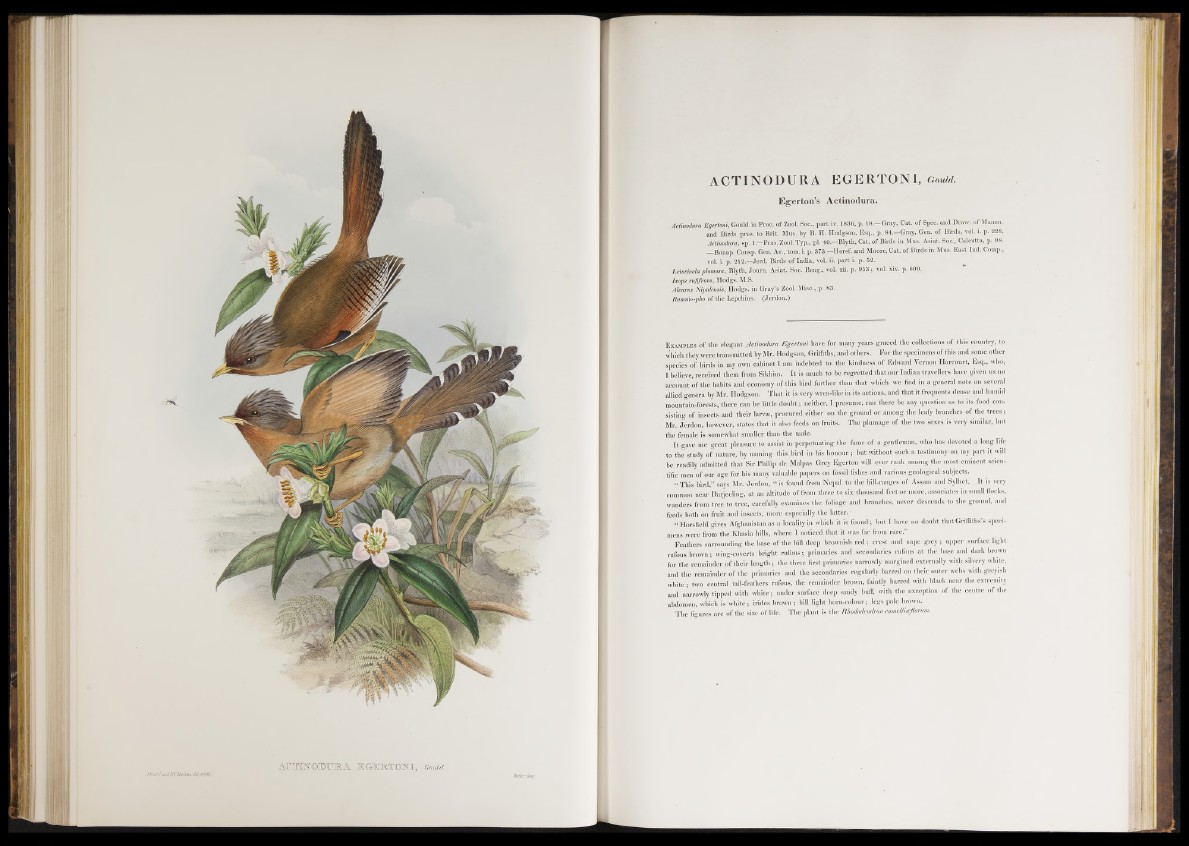
AC U N OjDBBA. E'GEMTOITI, Gem..
ACTINODURA EGERTONI, Gould.
Egerton’s Actinodura.
Actimiuro Egertom, Gould in Proc. o f Zool. Soc., part iv. 1836, p. 18.,-Gray, Cat. of Spec, and Draw, of Mamm.
and Birds pres, to Brit. Mus. by B. H. Hodgson, Esq., p. 84.—Gray, Gen. of Birds, vol. i. p. 226,
Actinodura, s f . 1.—Eras. Zool. Typ., pi. 40.—Blytb, Cat. of Birds in Mus. Asiat. Soc., Calcutta, p. 98.
- —Bonap. Consp. Geu. Av., tom. i. p. 373. -Horst, and Moore, Cat. o f Birds in Mus. East Ind. Comp.,
vol. i. p. 212.—Jerd. Birds o f India, vol. ii. part i. p. 52.
Leiocincla plumosa, Blyth, Joum. Asiat. Soc. Beng., vol. xii. p. 953; vol. xiv. p. 600.
Jxops rufifrons, Hodgs. M.S.
Alcurus Nipalensis, Hodgs. in Gray’s Zool. Misc., p. 83.
Rumnio-pho of tKe Lepchins. |Jerdon.)
E x am p l e s of the elegant Actinodura Egertom have for many years graced the collections o f this country, to
which they were transmitted by Mr. Hodgson, Griffiths, and others. For the specimens of this and some other
species of birds in my own cabinet I am indebted to the 'kindness of Edward Vernon Harcourt, Esq., who,
I believe, received them from Sikhim. It is muCti to be regretted that our Indian travellers have given us no
account of the habits and economy of this bird further than that which we find in a general note on several
allied genera by Mr. Hodgson. That it is very wren-like in its actions, and that it frequents dense and humid
mountain-forests, there can be little ¡g u b 't; neither, I presume, can there be any question as to its food consisting
o f insects and their larva, procured either on the ground or among the leafy branches of the tre e s ;
Mr. Jerdon, however, states that it also feeds on fruits. The plumage of the two sexes is very similar, but
the female is somewhat smaller than the male.
I t gave me great pleasure to assist in perpetuating the fame of a gentleman, who has devoted a long life
to the study o f nature, by naming this bird in his hon o u r; but without such a testimony on my p art it will
be readily admitted that Sir Phijip.de Malpas Grey Egerton will ever rank among the most eminent scientific
men of our age for his many valuable papers on fossil fishes and various geological subjects.
“ This bird,1’ says Mr. Jerdon, “ is found from Nepal to the hill-ranges of Assam and Sylhet. It is very
common near Darjeeling, at an altitude of from three to six thousand feet or more, associates in small flocks,
wanders from tree to tree, carefully examines the foliage and branches, never descends to the grouud, and
feeds both on fruit and insects, more especially the latter. ■
“ Horsfield gives Afghanistan as a locality in which it is found; but I have no doiibt that Griffiths's specimens
.were from the Khasia hills, where I noticed that it was far from rare.”
Feathers surrounding the base of the bill deep brownish red ; crest and nape g rey ; upper snrface light
rufous brown; wing-coverts bright rufous; primaries and secondaries rufons-at the base and dark brown
for the remainder of their len g th ; the three first primaries narrowly margined externally with silvery white,
and the remainder of the primaries and the secondaries regularly barred on their outer webs with greyish
white; two central tail-feathers rufous, the remainder brown, faintly barred with black near the extremity
and narrowly tipped with white; under surface deep sandy buff, with the exception of the centre of the
abdomen, which is white; irides brown ; bill light horn-cdour; legs pale brown.
The figures are of the size of life. The plant is the Rhododendron camellisrflonm.